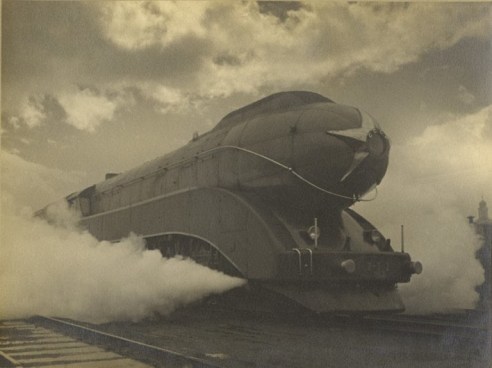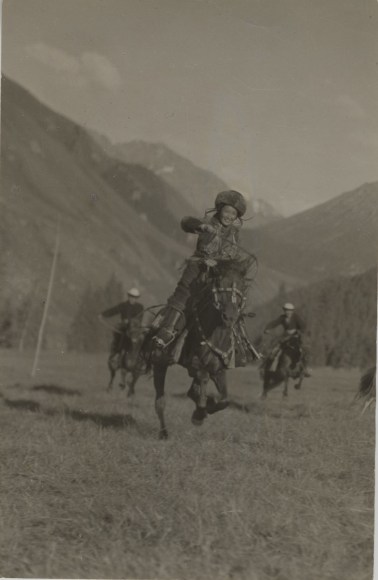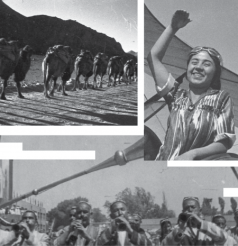
The power of Soviet photojournalist Max Alpert’s photographs lies in his mastery in capturing human emotion. Alpert’s humanist sensibility emerges in his intimately captured images of Soviet daily life, while his dramatic photographs on the front lines have come to symbolize the Soviet World II effort.
Alpert was born in Odessa in 1899 and in 1919, joined the Red Army. After three years of service, he moved to Moscow, where he began his career as a photojournalist for Rabochaia Gazeta, Pravda and Dom Pechati. Throughout the decade, Alpert collaborated with Pravda’s most prominent photojournalists such as Arkady Shaikhet, and Yakov Khalip. He would continue working with these figures well past his 1930 departure from the newspaper.
In 1931, Alpert, Shaikhet, Khalip and Semyon Fridlyand, founded The Revolutionary Society of Proletarian Photographers (ROPF), which would become one of the early 30s most prominent photojournalism organizations. ROPF’s widely-disseminated photographs of industrial sites, and proletarian workers were often accessible in content, and intended for a wide, proletarian audience. Their affinity for popular content distinguished them from the contemporaneous, formalist-focused organization, October, directed by Alexander Rodchenko and Boris Ignatovich.
One of Max Alpert’s best known ROPF projects was his 1931 collaboration with photographers Solomon Tules and Arkady Shaikhet on the series “Twenty-Fours in the Life of the Filippov Family,” published in the German weekly Arbeiter Illustrierte Zeitung (AIZ). The photographs provided a narrative of the secure and happy life of the Soviet worker in contrast to the lifestyle of workers in capitalist countries in the early 1930s. An exhibition of these photographs toured Vienna, Prague and Berlin in 1931. Alpert published a second notable series on Soviet lifestyle called “Giant and Builder,” which chronicles the career of Viktor Kalmykov, an illiterate mason who became a prominent construction worker at the Magnitogorsk steel foundry.
The subject matter of Max Alpert’s photographs in the early 1930s was greatly shaped by the goals of the Five Year Plan (1928-1932). The plan introduced large-scale industrial projects and agricultural collectivization in order to accelerate economic development in the Soviet Union. During this period, Alpert created a series about the construction of the hydroelectric plant on the Dneiper and a series on the construction of the Fergana Canal. Both appeared in the internationally-published magazine USSR in Construction, dedicated to documenting the industrial and social changes sweeping the Soviet Union.
During World War II, Alpert worked as a correspondent for the Russian news agency TASS in Prague, Berlin, and at the Soviet frontline. In 1942, he captured the photograph, Combat that depicts a military officer raising a pistol to give his unit the signal to attack. The gravitas of this tightly framed, and dramatically lit photograph, has made it among the war’s most iconic images. It has since been recreated in a monumental sculpture to political officers in Slovianoserbsk Raion, Ukraine, and on a 1985 postage stamp in the Republic of Congo, dedicated to the 40th anniversary of Victory Day. Alpert was awarded the Order of the Red Star, the Order of the Patriotic War, and the Order of the Red Banner of Labour for his service. His post-war years were spent as a reporter for the press agency RIA Novosti.
Alpert’s photographs have been exhibited internationally since the 1920s. In 1929, he was featured in the famous "Film und Foto" exhibition in Stuttgart, which helped popularize Soviet photography abroad. Ogonyok and Sovetskoe Foto, whose widely-consumed photography magazines have shaped the trajectory of Soviet photojournalism, exhibited his photographs through the 1930s. Alpert’s photographs were also exhibited in the 1935 landmark Moscow exhibition unifying works of artistic and photojournalistic excellence, "Masters of Soviet Photographic Art." Most recently, his photographs appeared in the Jewish Museum’s 2015 exhibition "The Power of Pictures," New York; and The Art Institute of Chicago’s 2017-2018 exhibition "Revoliutsiia! Demonstratsiia! Soviet Art Put to the Test."




